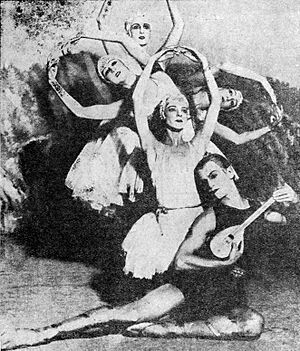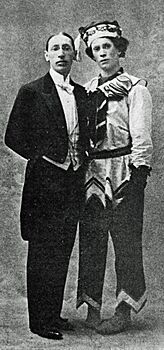Ballets Russes facts for kids
Quick facts for kids Ballets Russes |
|
|---|---|
| General information | |
| Name | Ballets Russes |
| Year founded | 1909 |
| Closed | 1929 |
| Principal venue | various |
| Artistic staff | |
| Artistic Director | Sergei Diaghilev |
| Other | |
| Formation |
|

The Ballets Russes (pronounced "Bal-lay Rooss") was a famous ballet company that started in Paris, France. It performed from 1909 to 1929 across Europe and in North and South America. The company never performed in Russia because of the Russian Revolution happening there. After its first shows in Paris, it didn't have official ties to Russia.
This company was created by Sergei Diaghilev, a talented organizer. Many people think Ballets Russes was the most important ballet company of the 20th century. This is because it brought together amazing young artists. These included choreographers (who create dances), composers (who write music), designers (who make sets and costumes), and dancers. Diaghilev asked famous people like Igor Stravinsky (composer), Pablo Picasso (artist), and Coco Chanel (costume designer) to work with the company.
The Ballets Russes shows were a huge hit! They made dance exciting again and helped many visual artists become well-known. They also introduced European and American audiences to Russian stories, music, and art. The company's use of new, modern art styles even influenced the Art Deco movement in the early 1900s.
Contents
What Does "Ballets Russes" Mean?
The name Ballets Russes is French and means "Russian Ballets." It specifically refers to the company started by Sergei Diaghilev. Sometimes, in early advertisements, it was called "Les Ballets Russes de Serge Diaghileff." In English, people usually just say "the Ballets Russes." In the early 1900s, it was also sometimes called "The Russian Ballet."
Other companies, like the Ballet Russe de Monte-Carlo and the Original Ballet Russe, formed after Diaghilev passed away in 1929. These names use the singular "Ballet Russe."
The Story of Ballets Russes

Sergei Diaghilev: The Visionary Founder
Sergei Diaghilev was the main reason for the company's success. He was like the "artistic director" of the group. Diaghilev came from a wealthy Russian family. This helped him connect with rich people who could support the ballet company. A very important sponsor was Winnaretta Singer, whose generous money helped Ballets Russes succeed in Europe.
Diaghilev loved music from a young age. He wanted to be a composer, but a famous composer told him he wasn't talented enough. So, he focused on organizing art instead. In 1898, he helped start an art magazine called Mir iskusstva (World of Art). This magazine reviewed ballets and showed Russian art.
Bringing Russian Art to Paris
Diaghilev felt that the art world in Russia was too old-fashioned. So, in 1906, he organized a big art show in Paris called Exhibition of Russian Art. It was the first major show of Russian art in the West and was a huge success. Parisians became fascinated with everything Russian.
After that, Diaghilev brought Russian music to the Paris Opera in 1907. In 1908, he brought the Russian opera Boris Godunov to Paris. These shows were very popular, but putting on grand operas was very expensive.
The First Ballet Season
In 1909, Diaghilev decided to focus only on ballet for his Paris "Saison Russe" (Russian Season). Most of the dancers were from the Mariinsky Ballet in Saint Petersburg. Diaghilev hired them to perform in Paris during their summer break. The first season included ballets like Le Pavillon d'Armide, the Polovtsian Dances, Les Sylphides, and Cléopâtre. These were mostly choreographed by Michel Fokine.
Famous Ballets and Productions
The Ballets Russes created many new and exciting ballets. Here are some of their most important productions:
| Year | Title | Image | Composer(s) | Choreographer(s) | Sets and costumes |
|---|---|---|---|---|---|
| 1909 | Le Pavillon d'Armide |  |
Nikolai Tcherepnin | Michel Fokine | Alexandre Benois |
| Prince Igor | 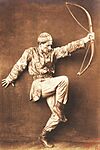 |
Alexander Borodin | Michel Fokine | Nicholas Roerich | |
| Le Festin | 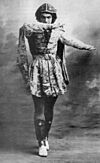 |
Nikolai Rimsky-Korsakov | Konstantin Korovin
Alexandre Benois |
||
| Mikhail Glinka | Michel Fokine, Marius Petipa | ||||
| Pyotr Ilyich Tchaikovsky | Marius Petipa | ||||
| Alexander Glazunov | Alexander Gorsky | ||||
| Modest Mussorgsky | Michel Fokine | ||||
| Mikhail Glinka | Nicolai Goltz, Felix Kchessinsky | ||||
| Pyotr Ilyich Tchaikovsky | Michel Fokine | ||||
| Alexander Glazunov | Marius Petipa | ||||
| Pyotr Ilyich Tchaikovsky | Michel Fokine | ||||
| Les Sylphides |  |
Frédéric Chopin | Michel Fokine | Alexandre Benois | |
| Cléopâtre |  |
Anton Arensky | Michel Fokine | Léon Bakst | |
| 1910 | Carnaval | 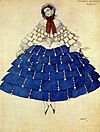 |
Robert Schumann | Michel Fokine | Léon Bakst |
| Schéhérazade |  |
Nikolai Rimsky-Korsakov | Michel Fokine | Léon Bakst | |
| Giselle |  |
Adolphe Adam | Jean Coralli, Jules Perrot, Marius Petipa, Michel Fokine | Alexandre Benois | |
| Les Orientales | 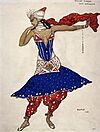 |
Christian Sinding, Edvard Grieg | Vaslav Nijinsky, Michel Fokine | Konstantin Korovin, Léon Bakst | |
| L'Oiseau de feu |  |
Igor Stravinsky | Michel Fokine | Alexander Golovine, Léon Bakst | |
| 1911 | Le Spectre de la rose |  |
Carl Maria von Weber | Michel Fokine | Léon Bakst |
| Narcisse |  |
Nikolai Tcherepnin | Michel Fokine | Léon Bakst | |
| Sadko |  |
Nikolai Rimsky-Korsakov | Mikhail Fokine | Boris Anisfeld | |
| Petrushka |  |
Igor Stravinsky | Michel Fokine | Alexandre Benois | |
| Swan Lake |  |
Pyotr Ilyich Tchaikovsky | Marius Petipa, Lev Ivanov, Michel Fokine | Konstantin Korovin, Alexander Golovin | |
| 1912 | L'après-midi d'un faune |  |
Claude Debussy | Vaslav Nijinsky | Léon Bakst |
| Daphnis et Chloé |  |
Maurice Ravel | Michel Fokine | Léon Bakst | |
| Le Dieu bleu |  |
Reynaldo Hahn | Michel Fokine | Léon Bakst | |
| Thamar |  |
Mily Balakirev | Michel Fokine | Léon Bakst | |
| 1913 | Jeux |  |
Claude Debussy | Vaslav Nijinsky | Léon Bakst |
| Le sacre du printemps |  |
Igor Stravinsky | Vaslav Nijinsky | Nicholas Roerich | |
| Tragédie de Salomé | Florent Schmitt | Boris Romanov | Sergey Sudeykin | ||
| 1914 | Les Papillons |  |
Robert Schumann | Mikhail Fokine | Mstislav Doboujinsky |
| La légende de Joseph |  |
Richard Strauss | Michel Fokine | Léon Bakst | |
| Le coq d'or |  |
Nikolai Rimsky-Korsakov | Michel Fokine | Natalia Goncharova | |
| Le rossignol |  |
Igor Stravinsky | Boris Romanov | Alexandre Benois | |
| 1915 | Soleil de Nuit |  |
Nikolai Rimsky-Korsakov | Léonide Massine | Mikhail Larionov |
| 1916 | Las Meniñas | Louis Aubert, Gabriel Fauré, Maurice Ravel, Emmanuel Chabrier | Léonide Massine | Josep Maria Sert | |
| Kikimora | Anatoly Liadov | Léonide Massine | Mikhail Larionov | ||
| Till Eulenspiegel |  |
Richard Strauss | Vaslav Nijinsky | Robert Edmond Jones | |
| 1917 | Feu d'Artifice | Igor Stravinsky | Giacomo Balla | ||
| Les Femmes de Bonne Humeur |  |
Domenico Scarlatti | Léonide Massine | Léon Bakst | |
| Parade | 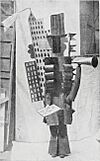 |
Erik Satie | Léonide Massine | Pablo Picasso | |
| 1919 | La Boutique fantasque |  |
Gioachino Rossini | Léonide Massine | André Derain |
| El sombrero de tres picos |  |
Manuel de Falla | Léonide Massine | Pablo Picasso | |
| Les jardins d'Aranjuez | Louis Aubert, Gabriel Fauré, Maurice Ravel, Emmanuel Chabrier | Léonide Massine | Josep Maria Sert | ||
| 1920 | Le chant du rossignol | Igor Stravinsky | Léonide Massine | Henri Matisse | |
| Pulcinella |  |
Igor Stravinsky | Léonide Massine | Pablo Picasso | |
| Ballet de l'astuce féminine | Domenico Cimarosa | Léonide Massine | Josep Maria Sert | ||
| Le sacre du printemps (revival) | Igor Stravinsky | Léonide Massine | Nicholas Roerich | ||
| 1921 | Chout |  |
Sergei Prokofiev | Léonide Massine | Mikhail Larionov |
| Cuadro Flamenco | Traditional Andalusian music | Pablo Picasso | |||
| The Sleeping Beauty |  |
Pyotr Tchaikovsky | Marius Petipa | Léon Bakst | |
| 1922 | Le Mariage de la Belle au Bois Dormant | Pyotr Tchaikovsky | Marius Petipa | Alexandre Benois, Natalia Goncharova | |
| Mavra |  |
Igor Stravinsky | Bronislava Nijinska | Léopold Survage | |
| Renard | Igor Stravinsky | Bronislava Nijinska | Mikhail Larionov | ||
| 1923 | Les noces |  |
Igor Stravinsky | Bronislava Nijinska | Natalia Goncharova |
| 1924 | Les Tentations de la Bergère | 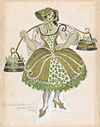 |
Michel de Montéclair | Bronislava Nijinska | Juan Gris |
| Le Médecin malgré lui |  |
Charles Gounod | Bronislava Nijinska | Alexandre Benois | |
| Les biches | Francis Poulenc | Bronislava Nijinska | Marie Laurencin | ||
| Cimarosiana | Domenico Cimarosa | Léonide Massine, Bronislava Nijinska | José-María Sert | ||
| Les Fâcheux | Georges Auric | Bronislava Nijinska | Georges Braque | ||
| Le train bleu | Darius Milhaud | Bronislava Nijinska | Henri Laurens, Gabrielle Chanel, Pablo Picasso | ||
| 1925 | Zephyr et Flore | Vladimir Dukelsky | Léonide Massine | Georges Braque | |
| Le chant du rossignol (revival) | Igor Stravinsky | George Balanchine | Henri Matisse | ||
| Les matelots | Georges Auric | Léonide Massine | Pere Pruna | ||
| Barabau | Vittorio Rieti | George Balanchine | Maurice Utrillo | ||
| 1926 | Roméo et Juliette | Constant Lambert | Bronislava Nijinska | Max Ernst, Joan Miró | |
| Pastorale | Georges Auric | George Balanchine | Pere Pruna | ||
| Jack in the Box | Erik Satie | George Balanchine | André Derain | ||
| The Triumph of Neptune | Lord Berners | George Balanchine | Pedro Pruna | ||
| 1927 | La chatte | Henri Sauguet | George Balanchine | Naum Gabo | |
| Mercure |  |
Erik Satie | Léonide Massine | Pablo Picasso | |
| Le pas d'acier |  |
Sergei Prokofiev | Léonide Massine | Georgy Yakulov | |
| 1928 | Ode | Nikolai Nabokov | Léonide Massine | Pavel Tchelitchev | |
| Apollon musagète (Apollo) |  |
Igor Stravinsky | George Balanchine | André Bauschant, Coco Chanel | |
| The Gods Go A-Begging |  |
George Frederic Handel | George Balanchine | Léon Bakst, Juan Gris | |
| 1929 | Le Bal | Vittorio Rieti | George Balanchine | Giorgio de Chirico | |
| Renard (revival) | Igor Stravinsky | Serge Lifar | Mikhail Larionov | ||
| Le fils prodigue | Sergei Prokofiev | George Balanchine | Georges Rouault |
What Happened After Diaghilev?
When Sergei Diaghilev passed away in 1929, the Ballets Russes owed a lot of money. The Great Depression was starting, so the company's things were taken by people they owed money to. The dancers went their separate ways.
Later, in 1931, two new companies were formed: the Ballets Russes de Monte-Carlo and the Original Ballet Russe. Many dancers and choreographers from Diaghilev's original company worked with these new groups. These successor companies helped keep the spirit of Ballets Russes alive.
After World War II started, the Ballet Russe de Monte Carlo toured a lot in the United States and South America. Many dancers from these companies later opened their own dance studios or taught at other schools. This helped spread the classical Russian ballet style around the world.
The Amazing Dancers
The Ballets Russes was known for its incredibly skilled dancers. Most of them had trained at the best Imperial schools in Russia. Their high level of skill was a big reason for the company's success in Paris. Dance technique in Paris had not been as strong for a long time.
Famous female dancers included Anna Pavlova, Tamara Karsavina, and Bronislava Nijinska. Many became internationally famous with the company.
The Ballets Russes also made male dancers much more important. Before this, male dancers were often not as noticed. Some of the amazing male dancers were Michel Fokine, Serge Lifar, Léonide Massine, and the legendary Vaslav Nijinsky. Nijinsky is often seen as the most popular and talented dancer in the company's history.
After the Russian Revolution of 1917, new dancers often came from Russian families living outside of Russia. Some dancers from America, like Ruth Page, also joined the group.
The Creative Choreographers
The Ballets Russes featured new and sometimes shocking works by great choreographers. These included Marius Petipa and Michel Fokine, as well as new talents like Vaslav Nijinsky, Bronislava Nijinska, Léonide Massine, and a young George Balanchine.
Michel Fokine: The First Innovator
Michel Fokine was very important to the early success of Ballets Russes. He trained at the Imperial Ballet School in Russia. In 1907, he created his first ballet, Le Pavillon d'Armide. He also created Chopiniana using music by Frédéric Chopin. This was new because he used existing music instead of music written just for the ballet.
Fokine became famous around the world for his work in the first four seasons (1909–1912) of Ballets Russes. His ballets included the Polovtsian Dances, Les Sylphides, The Firebird, Le Spectre de la Rose, Petrushka, and Daphnis and Chloé.
Vaslav Nijinsky: A Daring Artist
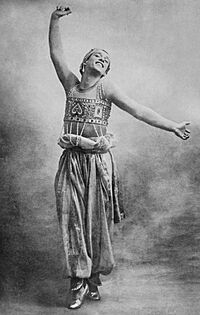
Vaslav Nijinsky started at the Imperial Ballet School when he was eight. He joined the Imperial Ballet in 1907 and quickly became a star. Diaghilev invited him to join Ballets Russes for its first season.
In 1912, Diaghilev gave Nijinsky a chance to be a choreographer. He created L'Après-midi d'un faune. The next year, Nijinsky choreographed Jeux and then Igor Stravinsky's famous The Rite of Spring. The Rite of Spring caused a huge stir with the audience because it was so different.
Léonide Massine: Expanding Ballet Stories
Léonide Massine studied acting and dancing in Moscow. Diaghilev invited him to join Ballets Russes to replace Vaslav Nijinsky. Diaghilev encouraged Massine to create his own dances.
Massine's most famous ballets for the company were Parade, El sombrero de tres picos, and Pulcinella. For all of these, he worked with Pablo Picasso, who designed the sets and costumes.
Massine added new ideas to Fokine's choreography. He used folk dances and a style called demi-charactère dance, which mixes classical ballet with character dances. He also created interesting contrasts in his dances, like movements that were together but also individual.
Bronislava Nijinska: A Female Choreographer

Bronislava Nijinska was Vaslav Nijinsky's younger sister. She also trained at the Imperial Ballet School. She joined Diaghilev's Ballets Russes in 1909.
During World War I, Nijinska went to Kiev, where she started a modern dance school. Later, in 1921, she rejoined Ballets Russes. In 1923, Diaghilev asked her to choreograph Stravinsky's Les Noces. This ballet combined her brother's style with more traditional ballet moves, like dancing en pointe (on the tips of the toes). The next year, she choreographed three more new works for the company.
George Balanchine: A Future Legend
George Balanchine was born in Saint Petersburg and trained at the Imperial School of Ballet. His studies were stopped by the Russian Revolution of 1917. After the school reopened, he also studied music. In 1924, Balanchine joined Ballets Russes as a choreographer. He would later become one of the most important choreographers in American ballet.
The Artistic Designers
Diaghilev asked many famous artists to design the sets and costumes for his ballets. These included Alexandre Benois, Léon Bakst, Pablo Picasso, Coco Chanel, and Henri Matisse.
Their designs made the company's shows incredibly exciting and new. For example, the costumes for Stravinsky's The Rite of Spring were so different that they helped cause a big stir at the first performance.
Even though they created amazing works, most of these designers were not trained for theater. They were usually studio painters.
Alexandre Benois: The Ballet Enthusiast
Alexandre Benois was one of the first people to help Diaghilev start the Mir iskusstva magazine. He loved ballet and greatly influenced Diaghilev's ideas. Benois also knew a lot about history and fashion. He designed sets and costumes for early Ballets Russes shows like Le Pavillon d'Armide and Giselle. He also helped create the story, sets, and costumes for Petrushka.
Léon Bakst: The Colorful Visionary
Léon Bakst was also an early member of the Mir iskusstva group. He designed for Ballets Russes from 1909 to 1921. He created sets and costumes for many famous ballets, including Scheherazade, The Firebird, Le Spectre de la rose, and Daphnis et Chloé.
Pablo Picasso: The Cubist Touch
In 1917, Pablo Picasso designed sets and costumes in his unique Cubist style for three Ballets Russes shows. All of these were choreographed by Léonide Massine: Parade, El sombrero de tres picos, and Pulcinella.
Natalia Goncharova: Inspired by Russian Folk Art
Natalia Goncharova was born in Russia in 1881. Her art was inspired by Russian folk art and modern art styles like Fauvism and Cubism. She started designing for Ballets Russes in 1921.
Composers and Conductors
Diaghilev asked the best composers of the 20th century to write music for his new ballets. These included Debussy, Prokofiev, Ravel, Satie, and Stravinsky. He also hired famous conductors like Pierre Monteux and Ernest Ansermet.
Igor Stravinsky: A Rising Star
Diaghilev hired the young Igor Stravinsky when he was not well-known. Stravinsky wrote the music for The Firebird. This helped launch Stravinsky's career in Europe and America.
Stravinsky's early ballet music caused a lot of talk. The Firebird (1910) was seen as amazing for such a young composer. Many people found Petrushka (1911) to be too harsh and confusing. The Rite of Spring (1913) almost caused a riot in the audience because of its wild rhythms and strong sounds. Today, Stravinsky's early ballet music is considered masterpieces.
Rare Film of a Performance
Diaghilev always said that cameras could not capture the beauty of his dancers. For a long time, people thought there were no films of the Ballets Russes. However, in 2011, a 30-second newsreel film was found. It showed a performance of Les Sylphides in Switzerland in 1928. The main dancer was identified as Serge Lifar.
Celebrating the Ballets Russes
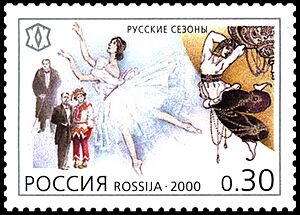
Over the years, there have been many exhibitions and celebrations of the Ballets Russes:
- Paris, 2008: An exhibition showed about 150 paintings, designs, costumes, and photos. It included works by André Derain, Henri Matisse, Léon Bakst, Pablo Picasso, and Jean Cocteau.
- Monte-Carlo, 2009: Two postage stamps were released to celebrate the 100th anniversary of Ballets Russes.
- London, 2010–11: The Victoria and Albert Museum had a special exhibition called Diaghilev and the Golden Age of the Ballets Russes, 1909–1929.
- Canberra, 2010–11: The National Gallery of Australia showed 150 costumes and accessories from 34 Ballets Russes productions. Many of these had not been seen since they were worn on stage.
- Washington, DC, 2013: The National Gallery of Art hosted an exhibition called Diaghilev and the Ballets Russes, 1909–1929: When Art Danced with Music.
- Stockholm, 2014–2015: The Dance Museum in Stockholm showed about fifty original costumes from the Ballets Russes.
Images for kids
-
Ballet Russes by August Macke, 1912
See also
 In Spanish: Ballets Rusos para niños
In Spanish: Ballets Rusos para niños
- List of productions of Swan Lake derived from its 1895 revival


